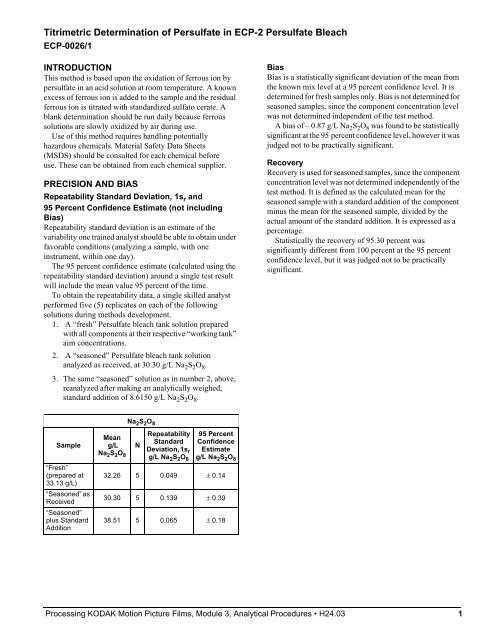Processing kodak motion picture films, module 3 analytical procedures
Processing kodak motion picture films, module 3 analytical procedures
Processing kodak motion picture films, module 3 analytical procedures
Create successful ePaper yourself
Turn your PDF publications into a flip-book with our unique Google optimized e-Paper software.
Titrimetric Determination of Persulfate in ECP-2 Persulfate Bleach<br />
ECP-0026/1<br />
INTRODUCTION<br />
This method is based upon the oxidation of ferrous ion by<br />
persulfate in an acid solution at room temperature. A known<br />
excess of ferrous ion is added to the sample and the residual<br />
ferrous ion is titrated with standardized sulfato cerate. A<br />
blank determination should be run daily because ferrous<br />
solutions are slowly oxidized by air during use.<br />
Use of this method requires handling potentially<br />
hazardous chemicals. Material Safety Data Sheets<br />
(MSDS) should be consulted for each chemical before<br />
use. These can be obtained from each chemical supplier.<br />
PRECISION AND BIAS<br />
Repeatability Standard Deviation, 1sr and<br />
95 Percent Confidence Estimate (not including<br />
Bias)<br />
Repeatability standard deviation is an estimate of the<br />
variability one trained analyst should be able to obtain under<br />
favorable conditions (analyzing a sample, with one<br />
instrument, within one day).<br />
The 95 percent confidence estimate (calculated using the<br />
repeatability standard deviation) around a single test result<br />
will include the mean value 95 percent of the time.<br />
To obtain the repeatability data, a single skilled analyst<br />
performed five (5) replicates on each of the following<br />
solutions during methods development.<br />
1. A “fresh” Persulfate bleach tank solution prepared<br />
with all components at their respective “working tank”<br />
aim concentrations.<br />
2. A “seasoned” Persulfate bleach tank solution<br />
analyzed as received, at 30.30 g/L Na2S2O8. 3. The same “seasoned” solution as in number 2, above,<br />
reanalyzed after making an <strong>analytical</strong>ly weighed,<br />
standard addition of 8.6150 g/L Na2S2O8. Sample<br />
“Fresh”<br />
(prepared at<br />
33.13 g/L)<br />
“Seasoned” as<br />
Received<br />
“Seasoned”<br />
plus Standard<br />
Addition<br />
Mean<br />
g/L<br />
Na 2 S 2 O 8<br />
Na 2 S 2 O 8<br />
N<br />
Repeatability<br />
Standard<br />
Deviation, 1s r<br />
g/L Na 2S 2O 8<br />
95 Percent<br />
Confidence<br />
Estimate<br />
g/L Na 2S 2O 8<br />
32.26 5 0.049 ± 0.14<br />
30.30 5 0.139 ± 0.39<br />
38.51 5 0.065 ± 0.18<br />
Bias<br />
Bias is a statistically significant deviation of the mean from<br />
the known mix level at a 95 percent confidence level. It is<br />
determined for fresh samples only. Bias is not determined for<br />
seasoned samples, since the component concentration level<br />
was not determined independent of the test method.<br />
A bias of – 0.87 g/L Na 2 S 2 O 8 was found to be statistically<br />
significant at the 95 percent confidence level, however it was<br />
judged not to be practically significant.<br />
Recovery<br />
Recovery is used for seasoned samples, since the component<br />
concentration level was not determined independently of the<br />
test method. It is defined as the calculated mean for the<br />
seasoned sample with a standard addition of the component<br />
minus the mean for the seasoned sample, divided by the<br />
actual amount of the standard addition. It is expressed as a<br />
percentage.<br />
Statistically the recovery of 95.30 percent was<br />
significantly different from 100 percent at the 95 percent<br />
confidence level, but it was judged not to be practically<br />
significant.<br />
<strong>Processing</strong> KODAK Motion Picture Films, Module 3, Analytical Procedures H24.03 1
















